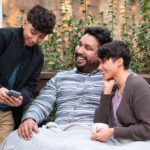MED-EL
Published Jul 16, 2021
The Benefits of Bilateral Cochlear Implants for Children & Adults

Cochlear implantation is internationally recognized as the standard of care for patients with severe-to-profound hearing loss [4,28], with bilateral implantation regarded as the gold standard.
However, despite a well-established body of research highlighting the cost-effectiveness of bilateral cochlear implantation and improved quality of life outcomes, it is believed that just 4.2% of people who are eligible for cochlear implants have access to them [30]. In many developing nations, this figure is expected to be significantly lower.
Outcomes Compared: Unilateral & Bilateral Implantation
A recent MED-EL survey identified that 18% of unilateral users said their country provides financial support for unilateral implantation only, and that 22% of current bilateral recipients surveyed had to actively pursue a second implant where funding was available [23]. This is despite hearing experts and an ever-growing body of medical research reaching broad consensus that bilateral implantation offers clear advantages over unilateral implantation.
Studies have shown that access to binaural cues, thus enabling binaural hearing, can deliver the following benefits [1,10,19,20,29]:
- Improved speech recognition in quiet and background noise
- Enhanced sound localization
- Reduced listening effort and related fatigue
- Enriched quality of life
- Reduced head shadow effect for improved signal-to-noise ratio
- Binaural summation benefit
- Health-related quality of life
- Improved language development for children and positive impact on phonological processing skills
Parents also report their child’s responsiveness in groups, reaction time, and language acquisition to be significantly improved following bilateral implantation [40].
Subjective expectations of unilateral cochlear implant users also identify improved quality of life, reduced exhaustion, and better hearing in noise as the perceived potential benefits of bilateral cochlear implant use over-and-above their current listening experience [23].
Inter-Implant Intervals & Sequential Implantation
Robust evidence spanning decades details the long-term socio-economic and audiological outcomes that support simultaneous bilateral implantation as the recommended and safe treatment option for children [6].
However, the question of whether to sequentially implant existing unilateral patients is too often still discussed, with factors such as inter-implant interval, pre- or post-lingual duration of hearing loss, and unilateral performance among the core discussion topics.
“…bilateral cochlear implants (BiCI) are better than unilateral cochlear implant,
and simultaneous BiCI is preferred than the sequential cochlear implant even after
escaping the early stage of language development.” [9]
Importantly, research suggests that minimizing the time delay between the first and second implant is important to maximize patient outcomes [12,29]. That said, auditory deprivation is not a contraindication to cochlear implantation [37], and “…even after a long period of deafness and despite a prolonged inter-stage interval, sequential bilateral cochlear implantation should be considered” [3].
Multiple studies support this, suggesting pediatric bilateral benefits are achieved irrespective of the inter-implant interval, age, and duration of use of the second CI, with patients showing functional binaural benefit, sound localization, and improved speech perception in quiet and noise [1,16,17].
In post-lingually deafened adults, a growing body of evidence continues to highlight subjective and objective sequential benefits including speech intelligibility in quiet and noise, as well as quality of life regardless of age at implantation and inter-implant intervals [26,34].
Quality of Life Indicators Support Bilateral Cochlear Implantation

Compared to other chronic diseases such as diabetes, hypertension, angina, and heart failure, studies have shown that hearing loss has a greater impact on a person’s quality of life [14,33]. Extensive research cites social isolation, depression, cognitive decline, low self-confidence, and related health issues among the scenarios that those living with untreated hearing loss often face [27,32]. Thus, untreated hearing loss places additional hidden burdens on healthcare systems [8].
When evaluating Quality of Life outcomes against generic population or intervention metrices, or disease-specific measures, several studies have shown statistically significant increases in quality of life following bilateral cochlear implantation in both adults and children [5,15,22,31]. A global survey of bilateral cochlear implant users and parents also found that 99% of participants identified an improvement in their quality of life as one of the most important benefits of their bilateral implant [23].
Such improvements in adults have been reported across all ages, including a prospective cohort analysis of older adults ages 80+ years [18]. In large adult study groups, statistically significant health utility gains were recorded with HUI-3 and NCIQ when comparing bilateral implantation versus unilateral implantation. When considering bilateral versus no-intervention with or without hearing aids, the health utility gain further increases. In addition, these outcomes are consistent across sequentially and simultaneously implanted patients [5,7,13,15,21,24].
Similar results are available in pediatric cohort studies, with clinicians recording statistically significant health utility gains using HUI-3 when comparing bilateral to unilateral implantation and when considering bilateral versus no treatment, with or without hearing aids [2,6,22,31].
Cost-Effectiveness of Bilateral Implantation
In children living with bilateral sensorineural hearing loss, the cost-effectiveness of bilateral intervention is clear when compared to both hearing aids and unilateral cochlear implantation [15,25]. The same has been shown for adults as a growing body of evidence indicates that bilateral cochlear implantation is cost-effective compared to no treatment, hearing aids, or unilateral implantation [11,35,36].
Importantly, simultaneous bilateral cochlear implantation is shown to be more cost-effective compared to sequential bilateral implantation in both adults and children [35,39]. In developing countries, evidence also notes the cost-effectiveness of bilateral implantation [38,41].
Achieving Universal Access to Bilateral Cochlear Implants
The decades of research outlined above provide strong evidence to support bilateral cochlear implantation. However, despite the evidence, access to bilateral cochlear implantation remains out of reach for families unable to shoulder the financial burden of private treatment in many developed and developing nations across the globe.
We encourage policymakers to engage with national and international experts, including the HEARRING Group or the Hearing Health Forum EU, to facilitate the reimbursement of bilateral cochlear implants for both children and adults.
Subscribe & Share
Don’t miss informative future updates like this from our MED-EL Professionals Blog—subscribe now.
References
[1] Almeida, G. F. L., Martins, M. F., Costa, L. B. A. D., Costa, O. A. D., & Martinho De Carvalho, A. C. (2019). Sequential bilateral cochlear implant: results in children and adolescents. Brazilian Journal of Otorhinolaryngology, 85(6), 774–779. https://doi.org/10.1016/j.bjorl.2018.07.008
[2] Barton, G. R., Stacey, P. C., Fortnum, H. M., & Summerfield, A. Q. (2006). Hearing-impaired children in the United Kingdom, IV: cost-effectiveness of pediatric cochlear implantation. Ear Hear, 27(5), 575-588. https://doi.org/10.1097/01.aud.0000233967.11072.24
[3] Bianchin, G., Tribi, L., Formigoni, P., Russo, C., & Polizzi, V. (2017). Sequential pediatric bilateral cochlear implantation: The effect of time interval between implants. International Journal of Pediatric Otorhinolaryngology, 102, 10–14. https://doi.org/10.1016/j.ijporl.2017.08.025
[4] Buchman, C. A., Gifford, R. H., Haynes, D. S., Lenarz, T., O’Donoghue, G., Adunka, O., Biever, A., Briggs, R. J., Carlson, M. L., Dai, P., Driscoll, C. L., Francis, H. W., Gantz, B. J., Gurgel, R. K., Hansen, M. R., Holcomb, M., Karltorp, E., Kirtane, M., Larky, J., Mylanus, E. A. M., Roland, J. T., Jr., Saeed, S. R., Skarzynski, H., Skarzynski, P. H., Syms, M., Teagle, H., Van de Heyning, P. H., Vincent, C., Wu, H., Yamasoba, T., & Zwolan, T. (2020). Unilateral Cochlear Implants for Severe, Profound, or Moderate Sloping to Profound Bilateral Sensorineural Hearing Loss: A Systematic Review and Consensus Statements. JAMA Otolaryngol Head Neck Surg. https://doi.org/10.1001/jamaoto.2020.0998
[5] Chen, J. M., Amoodi, H., & Mittmann, N. (2014). Cost-utility analysis of bilateral cochlear implantation in adults: a health economic assessment from the perspective of a publicly funded program. Laryngoscope, 124(6), 1452-1458. https://doi.org/10.1002/lary.24537
[6] Cheng, L. J., Soon, S. S., Wu, D. B., Ju, H., & Ng, K. (2019). Cost-effectiveness analysis of bilateral cochlear implants for children with severe-to-profound sensorineural hearing loss in both ears in Singapore. PLoS One, 14(8), e0220439. https://doi.org/10.1371/journal.pone.0220439
[7] Crowson, M. G., Semenov, Y. R., Tucci, D. L., & Niparko, J. K. (2017). Quality of Life and Cost-Effectiveness of Cochlear Implants: A Narrative Review. Audiol Neurootol, 22(4-5), 236-258. https://doi.org/10.1159/000481767
[8] D’Haese, P. S. C., Van Rompaey, V., De Bodt, M., & Van de Heyning, P. (2019). Severe Hearing Loss in the Aging Population Poses a Global Public Health Challenge. How Can We Better Realize the Benefits of Cochlear Implantation to Mitigate This Crisis? Front Public Health, 7, 227. https://doi.org/10.3389/fpubh.2019.00227
[9] Elrashidy, R., Khater, A. M., Shabana, M., Khashaba, A., & Tharwat, A. (2020). Bilateral cochlear implantation: simultaneous versus sequential. The Egyptian Journal of Otolaryngology, 36(1), 16-16. https://doi.org/10.1186/s43163-020-00015-3
[10] Eskridge, H. R., Park, L. R., & Brown, K. D. (2021). The impact of unilateral, simultaneous, or sequential cochlear implantation on pediatric language outcomes. Cochlear Implants Int, 1-8. https://doi.org/10.1080/14670100.2020.1871267
[11] Foteff, C., Kennedy, S., Milton, A. H., Deger, M., Payk, F., & Sanderson, G. (2016). Cost-Utility Analysis of Cochlear Implantation in Australian Adults. Otol Neurotol, 37(5), 454-461. https://doi.org/10.1097/mao.0000000000000999
[12] Grieco-Calub, T. M., & Litovsky, R. Y. (2010). Sound localization skills in children who use bilateral cochlear implants and in children with normal acoustic hearing. Ear Hear, 31(5), 645-656. https://doi.org/10.1097/AUD.0b013e3181e50a1d
[13] Harkonen, K., Kivekas, I., Rautiainen, M., Kotti, V., Sivonen, V., & Vasama, J. P. (2015). Sequential bilateral cochlear implantation improves working performance, quality of life, and quality of hearing. Acta Otolaryngol, 135(5), 440-446. https://doi.org/10.3109/00016489.2014.990056
[14] Hawkins, K., Bottone, F. G., Jr., Ozminkowski, R. J., Musich, S., Bai, M., Migliori, R. J., & Yeh, C. S. (2012). The prevalence of hearing impairment and its burden on the quality of life among adults with Medicare Supplement Insurance. Qual Life Res, 21(7), 1135-1147. https://doi.org/10.1007/s11136-011-0028-z
[15] Health Quality Ontario. (2018). Bilateral Cochlear Implantation: A Health Technology Assessment. Ont Health Technol Assess Ser.
[16] Jang, J. H., Roh, J.-M., Choo, O. S., Kim, Y.-J., Kim, H., Park, H. Y., & Choung, Y.-H. (2019). Critical Factors for Binaural Hearing in Children with Bilateral Sequential Cochlear Implantation: First Implant Performance and Inter-Implant Interval [https://doi.org/10.1159/000500700]. Audiology & neuro-otology, 24(4), 174-182.
[17] Killan, C. F., Killan, E. C., & Raine, C. H. (2015). Changes in children’s speech discrimination and spatial release from masking between 2 and 4 years after sequential cochlear implantation [https://doi.org/10.1179/1754762815Y.0000000001]. Cochlear Implants Int, 16(5), 270-276.
[18] Knopke, S., Grabel, S., Forster-Ruhrmann, U., Mazurek, B., Szczepek, A. J., & Olze, H. (2016). Impact of cochlear implantation on quality of life and mental comorbidity in patients aged 80 years. Laryngoscope, 126(12), 2811-2816. https://doi.org/10.1002/lary.25993
[19] Laske, R. D., Veraguth, D., Dillier, N., Binkert, A., Holzmann, D., & Huber, A. M. (2009). Subjective and objective results after bilateral cochlear implantation in adults [https://doi.org/10.1097/MAO.0b013e31819bd7e6]. Otol Neurotol, 30(3), 313-318.
[20] Lee, Y. (2021). Benefit of Bilateral Cochlear Implantation on Phonological Processing Skills in Deaf Children. Otology & Neurotology, Publish Ahead of Print. https://journals.lww.com/otology-neurotology/Fulltext/9000/Benefit_of_Bilateral_Cochlear_Implantation_on.95691.aspx
[21] Litovsky, R., Parkinson, A., Arcaroli, J., & Sammeth, C. (2006). Simultaneous bilateral cochlear implantation in adults: a multicenter clinical study. Ear Hear, 27(6), 714-731. https://doi.org/10.1097/01.aud.0000246816.50820.42
[22] Lovett, R. E., Kitterick, P. T., Hewitt, C. E., & Summerfield, A. Q. (2010). Bilateral or unilateral cochlear implantation for deaf children: an observational study. Arch Dis Child, 95(2), 107-112. https://doi.org/10.1136/adc.2009.160325
[23] MED-EL. (2020). Bilateral Cochlear Implant Survey. Data on File.
[24] Olze, H., Grabel, S., Haupt, H., Forster, U., & Mazurek, B. (2012). Extra benefit of a second cochlear implant with respect to health-related quality of life and tinnitus. Otol Neurotol, 33(7), 1169-1175. https://doi.org/10.1097/MAO.0b013e31825e799f
[25] Pérez-Martín, J., Artaso, M. A., & Díez, F. J. (2017). Cost-effectiveness of pediatric bilateral cochlear implantation in Spain. Laryngoscope, 127(12), 2866-2872. https://doi.org/10.1002/lary.26765
[26] Péus, D., Pfluger, A., Häussler, S. M., Knopke, S., Ketterer, M. C., Szczepek, A. J., Gräbel, S., & Olze, H. (2020). Single-centre experience and practical considerations of the benefit of a second cochlear implant in bilaterally deaf adults [https://doi.org/10.1007/s00405-020-06315-x]. Eur Arch Otorhinolaryngol.
[27] Ramakers, G. G., Smulders, Y. E., van Zon, A., Kraaijenga, V. J., Stegeman, I., Van Zanten, G. A., & Grolman, W. (2016). Agreement between health utility instruments in cochlear implantation. Clin Otolaryngol, 41(6), 737-743. https://doi.org/10.1111/coa.12626
[28] Ramsden, J. D., Gordon, K., Aschendorff, A., Borucki, L., Bunne, M., Burdo, S., Garabedian, N., Grolman, W., Irving, R., Lesinski-Schiedat, A., Loundon, N., Manrique, M., Martin, J., Raine, C., Wouters, J., & Papsin, B. C. (2012). European Bilateral Pediatric Cochlear Implant Forum consensus statement. Otol Neurotol, 33(4), 561-565. https://doi.org/10.1097/MAO.0b013e3182536ae2
[29] Reeder, R. M., Firszt, J. B., Holden, L. K., & Strube, M. J. (2014). A longitudinal study in adults with sequential bilateral cochlear implants: time course for individual ear and bilateral performance [https://doi.org/10.1044/2014_JSLHR-H-13-0087]. Journal of speech, language, and hearing research : JSLHR, 57(3), 1108-1126.
[30] Saunders, J. E., Francis, H. W., & Skarzynski, P. H. (2016). Measuring Success: Cost-Effectiveness and Expanding Access to Cochlear Implantation. Otol Neurotol, 37(2), e135-140. https://doi.org/10.1097/mao.0000000000000942
[31] Semenov, Y. R., Yeh, S. T., Seshamani, M., Wang, N. Y., Tobey, E. A., Eisenberg, L. S., Quittner, A. L., Frick, K. D., & Niparko, J. K. (2013). Age-dependent cost-utility of pediatric cochlear implantation. Ear Hear, 34(4), 402-412. https://doi.org/10.1097/AUD.0b013e3182772c66
[32] Shield, B. (2019). Hearing Loss – Numbers and Costs: Evaluation of the social and economic costs of hearing impairment Hear-IT AISBL
[33] Simpson, A. N., Simpson, K. N., & Dubno, J. R. (2015). Health-related quality of life in older adults: Effects of hearing loss and common chronic conditions. Healthy Aging Res, 4. https://doi.org/10.12715/har.2015.4.4
[34] Sivonen, V., Sinkkonen, S. T., Willberg, T., Lamminmäki, S., Jääskelä-Saari, H., Aarnisalo, A. A., & Dietz, A. (2021). Improvements in Hearing and in Quality of Life after Sequential Bilateral Cochlear Implantation in a Consecutive Sample of Adult Patients with Severe-to-Profound Hearing Loss. J Clin Med, 10(11). https://doi.org/10.3390/jcm10112394
[35] Skarzynski, P. H., Ciesla, K., Lorens, A., Wojcik, J., & Skarzynski, H. (2021). Cost-Utility Analysis of Bilateral Cochlear Implantation in Adults With Severe to Profound Sensorineural Hearing Loss in Poland. Otology & Neurotology, Publish Ahead of Print. https://doi.org/10.1097/mao.0000000000003040
[36] Smulders, Y. E., van Zon, A., Stegeman, I., van Zanten, G. A., Rinia, A. B., Stokroos, R. J., Free, R. H., Maat, B., Frijns, J. H., Mylanus, E. A., Huinck, W. J., Topsakal, V., & Grolman, W. (2016). Cost-Utility of Bilateral Versus Unilateral Cochlear Implantation in Adults: A Randomized Controlled Trial. Otol Neurotol, 37(1), 38-45. https://doi.org/10.1097/mao.0000000000000901
[37] Sorrentino, F., Gheller, F., Lunardi, G., Brotto, D., Trevisi, P., Martini, A., Marioni, G., & Bovo, R. (2020). Cochlear implantation in adults with auditory deprivation: What do we know about it? Am J Otolaryngol, 41(2), 102366. https://doi.org/10.1016/j.amjoto.2019.102366
[38] Swami, H., Ap, A., & Shivanand, S. (2021). Cost-effectiveness of Pediatric Unilateral/Bilateral Cochlear Implant in a Developing Country. Otol Neurotol, 42(1), e33-e39. https://doi.org/10.1097/MAO.0000000000002862
[39] Trinidade, A., Page, J. C., Kennett, S. W., Cox, M. D., & Dornhoffer, J. L. (2017). Simultaneous versus sequential bilateral cochlear implants in adults: Cost analysis in a US setting. Laryngoscope, 127(11), 2615-2618. https://doi.org/10.1002/lary.26673
[40] Winkler, F., Schön, F., Peklo, L., Müller, J., Feinen, C., & Helms, J. (2002). [The Würzburg questionnaire for assessing the quality of hearing in CI-children (WH-CIK)]. Laryngorhinootologie, 81(3), 211-216. https://doi.org/10.1055/s-2002-25042
[41] World Health Organization. (2021). World Report on Hearing. W. H. Organization.
MED-EL
Was this article helpful?
Thanks for your feedback.
Sign up for newsletter below for more.
Thanks for your feedback.
Please leave your message below.
CTA Form Success Message
Send us a message
Field is required
John Doe
Field is required
name@mail.com
Field is required
What do you think?
MED-EL



